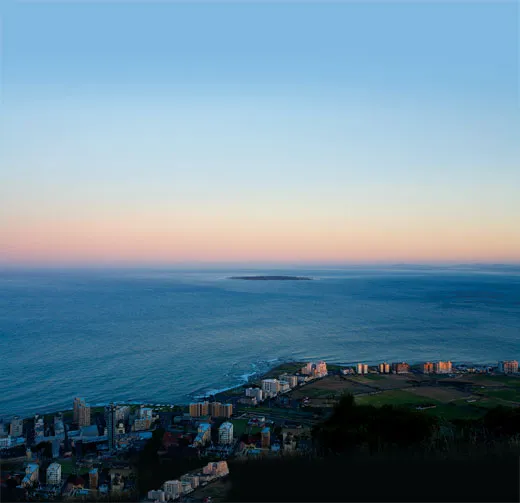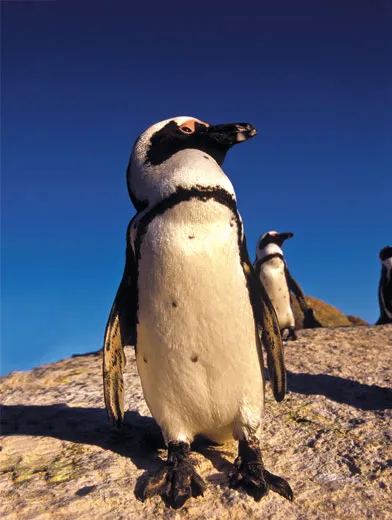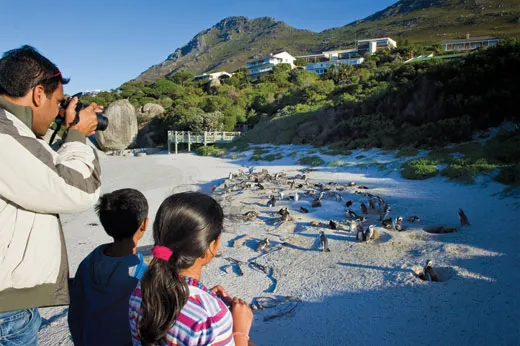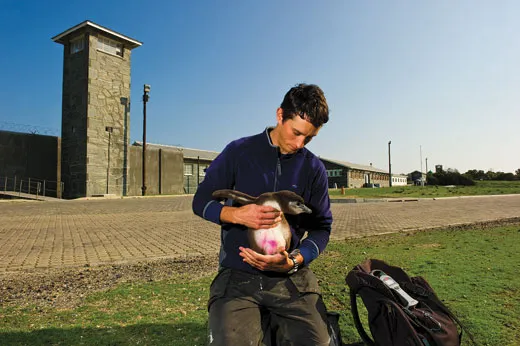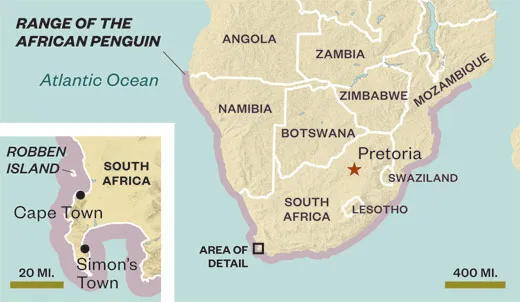Make Way for the African Penguins
Few places let you get as close to the raffish birds—many of which are endangered—as South Africa’s Robben Island
The lives of penguins on South Africa’s Robben Island are defined by the rhythms of their daily commute. Every morning, they parade down penguin highways to the sea, and every evening they return to their nests along the same paths, full of half-digested fish that they regurgitate to their whining chicks.
I was crouched behind a camouflage net to avoid scaring skittish birds on their way home after a long day of fishing. My job was to read the numbers on flipper bands. Scientists have banded about 4,000 chicks and 40,000 adult penguins in this area over the past 33 years to find out how long they live and where they feed, swim and nest.
Eight penguins, not yet tagged, teetered on the crest of a sloping rock face and stopped just a few feet away to soak up the last of the sun. These are not the world’s most beautiful penguins. They don’t have the aristocratic bearing and the polar mystique of the emperor penguin. They’re not as brightly colored as the king penguin, with its glowing gold neck and nape, probably the most beautiful of all penguins. Nor do they have the shining yellow head feathers of the crested species, the macaroni and rockhopper penguins.
The African penguin, though, is handsome in its own simple way. A single band of black loops around its white belly and chest, from foot to foot, like a horseshoe. White stripes curve around its black cheeks, giving the bird the appearance of wearing a white hood. A few black spots mark the chest, different for each bird. The only decorative flair is a patch of pink skin from eye to beak.
The birds continued their hike home, heading inland to their waiting chicks, which were already begging for food. I heard a cacophony of braying as penguins still at the nest called out to guide their mates home. A harsh and hoarse donkey sound, the call earned the birds their former name: jackass penguins. Every night the island echoes with tone-deaf serenades, sung to establish and affirm mating bonds. They honk out a loud chorus, chests pumping like bellows and beaks pointed to the sky. The penguins might seem operatic if their songs weren’t so ridiculously unmusical.
Something about the daily migration captures the animals’ dignity and comedy. They are so purposeful, so earnest, so serious in their stiff-legged waddle, wings rigidly forward. Often as I watched, they would hear a noise or see something startling, like a gull, and the entire group would dissolve in a general panic, fleeing in all directions, using their flippers like front legs, even running over each other.
African penguins have not been celebrated in movies, but they find themselves on center stage now as one of the world’s most endangered penguins. Researchers have been studying penguins here since the early 1980s, and their work has shed a harsh light on a species in free fall, with a population down more than 95 percent in 100 years. “I hate to say it,” says Richard Sherley, a biologist at the University of Cape Town who now runs the Robben Island study, “but unless something serious changes, the African penguin may be on its way out.”
Robben Island is best known as the site of the former maximum-security prison that once held Nelson Mandela and other anti-apartheid activists, and one morning I accompanied Sherley to the dense acacia trees in front of the hulking structure, now a museum (see “A Monument to Courage,”). Sherley fought through heavy brush to reach a young chick in its nest, a hollow in the sand about the size of a kitchen sink. Flippers out and oversize feet cocked upward, the penguin chick squirmed in Sherley’s grip. He lifted it and handed it to me.
For sheer cuteness, the baby penguin was tough to top. It looked more like a bottom-heavy stuffed toy than a living creature; it was covered in a thick velour of down and was mostly gray except for its white belly and bulging white cheeks.
“Watch out for the beak,” Sherley said, bringing me back to the task at hand. “Oh, and the poop, too—a stream of hot fish soup.”
In my nearly two weeks with Sherley, he surveyed nests, conducted penguin counts and rescued birds—not just penguins but also gannets, cormorants and petrels—that looked sick or in trouble.
We put the penguin chick in a green bag, careful to avoid both ends of the bird, and weighed it on a fish scale—about five pounds. Its flippers were just over seven inches long. Through the morning, we weighed and measured 21 chicks, part of a study on the condition and growth rates of the babies. “To see if they’re properly nourished,” Sherley explained.
He handed me the chick to put back in the nest. It was tough and well-muscled, like a stocky Jack Russell terrier. I set it down near its nest and it scurried to its nest-mate. They merged into a single, indistinguishable pile of gray down.
One of the biggest misconceptions about penguins is that they live on ice. Their name conjures up images of the South Pole and long marches through the Antarctic winter. In fact, only 2 of the 17 penguin species are exclusively Antarctic birds, and only 5 species can be found there. The rest live throughout the Southern Hemisphere. One species, the Galápagos penguin, ventures just north of the Equator.
The African penguin occurs from Namibia down the coast to the cape of South Africa, mainly on offshore islands. Only four colonies are on the mainland. In 1985, a bunch of penguins established a breeding colony on a breathtaking beach near Simon’s Town, on False Bay, a short drive from Cape Town. A boardwalk now allows hundreds of thousands of tourists every year to enjoy the birds’ antics. They may be the most urban penguins in the world.
The African penguin was the first kind of penguin documented in European history. On November 22, 1497, an anonymous member of Vasco da Gama’s crew recorded seeing “birds as big as ducks, but they cannot fly.” He continued: “These birds, of whom we killed as many as we chose . . . bray like asses.”
The encounter prefigured the exploitation of the penguins throughout their range over the next several centuries by explorers, whalers and settlers; they slaughtered the birds for food or collected their eggs to eat. Others gathered the guano for fertilizer, a practice that also removed soil and prevented penguins from digging burrows for nests.
On Robben Island, there was so much hunting and harvesting that the penguins disappeared by the late 1800s. They began to return only in the 1980s, well after the island had been turned into a notorious political prison and been made off-limits to hunters.
Overall, though, the African penguin made it into the 20th century in good shape. “Early photographs show that penguins covered their islands in unspeakable numbers,” Sherley told me. The decline is so dramatic that it’s worth giving in some detail.
In 1910, the penguin population in all of Africa was between 1.5 million and 3 million.
In 1956, the population was estimated at 300,000 birds.
In 1993, that number was down to perhaps 140,000.
By 2009, the time of the most recent in-depth survey, there were about 81,000.
The scientific name of the African penguin is Spheniscus demersus, or “plunging wedge,” referring to the bird’s superb swimming and diving abilities. But it might just as well refer to the species’ plunging population.
Eleven penguin species are classified as vulnerable or endangered. The Humboldt penguin, which is found from Chile to Peru, numbered more than a million birds in the 19th century. The population now may be just 25,000. Northern rockhopper penguins, which live on a few islands in the southern seas, have declined 90 percent in recent decades.
Historically, the problems facing penguins seemed clear: hunting, egg collecting, alien predators like cats and rats, and oil spills. These problems still beset penguins, and each species faces its own particular threats. The wreck of the ship MV Treasure in 2000, for example, spilled 1,300 tons of petroleum near Robben Island, oiling 19,000 birds. The latest dangers are more elusive, more global and more difficult to solve: overfishing, climate change and marine degradation. African penguins are susceptible to nearly all these threats, and Sherley warns they could be caught in an “extinction vortex.”
Dee Boersma, a penguin expert from the University of Washington, has studied the Magellanic penguin in Argentina for about 30 years. She says penguins are “marine sentinels,” indicators of the general state of the world’s oceans. “Penguins are reflecting rapid changes in the marine environment,” she writes, and their falling numbers suggest that, so far, “people are doing a poor job of managing the oceans.”
Still, research on the African penguin has benefited the species. The penguins had been forced to nest in the open, vulnerable to storms and floods and predators like gulls, largely because the island’s soil had been stripped by guano collectors. Researchers began building little huts for the birds to nest in—penguin “igloos.” Sherley says “birds in the artificial nest boxes breed more successfully than those in the bushes or natural burrows on Robben Island.”
Another crucial advance came after the 2000 oil spill. Getting oiled by a spill reduces a bird’s ability to rear chicks successfully for the rest of its life, even when it has been professionally washed and rehabilitated. But chicks hand-reared after a spill have fared as well as normal chicks, perhaps even better—a finding that has catalyzed increased efforts to take care of abandoned or imperiled chicks.
Flipper-banding studies have shown that protecting these penguins is urgent. The survival rate in adults, which commonly live 10 to 14 years, has decreased by 22 percent since the early 2000s. “In long-lived species like seabirds,” Sherley says, “decreased adult survivability is pretty much a sure sign that something is seriously wrong.”
The adult male penguin on Sherley’s lap looked like a black-and-white torpedo, fat and round and tapering to the pointed beak. It also looked as if it could explode at any minute and bolt from his grip. Sherley controlled it with both hands, one behind the bird’s head and the other hugging it close to his body.
Biologist Kate Robinson from the University of Cape Town moved quickly to attach a small recording device on its back. She used black tape to secure the electronic backpack to the penguin’s feathers. It was a GPS device that records location, depth of dives, temperature of the water and other information. “We’ll retrieve the logger when he comes back,” Robinson said.
Maps generated by such loggers have shown that these penguins travel about 20 miles on their foraging trips and can swim as far as 100 miles round-trip. But much of the time they’re fishing close to the colony. “They work their socks off to fish,” Sherley said.
Lately they’ve had to work much harder. The preferred prey of African penguins—anchovies and sardines—has been disappearing in much of the penguin’s range. The fish have moved some 250 miles to the southeast. Bound to their nesting colonies, the penguins cannot follow them. Studies by Robert Crawford of South Africa’s Department of Environmental Affairs and Tourism show that the breeding success and the survivability of these penguins are directly connected to the availability of anchovies and sardines.
What has caused the fish to move has proved elusive. “I suspect a suite of factors,” Crawford said. “That includes environmental change. There’s plenty of evidence of change in the Benguela Current.” The current carries frigid, nutrient-rich waters from Antarctica, and it has warmed at the southern and northern edges and shifted to the east.
Another problem may be overfishing. Over the past six decades, South African fishermen have harvested about 400,000 tons of sardines annually in the purse seine fishery. One study puts the local fish “carrying capacity” (a measure of potential population) at only 10 to 20 percent of what it was a century ago.
The South African government recently started restricting fishing temporarily in areas near breeding colonies. It’s an experiment to see whether protecting marine areas can improve seabird populations. “A few years ago, there was no consideration of the impact of the fishery on seabirds,” says Sherley. “Today, the possibility that the fishery may be contributing to the declines is being taken seriously.”
When I came to Robben Island, I expected to be won over by the penguins. They did not disappoint. I could watch them endlessly. Perhaps their charm derives from their similarity to us. More than any other bird, they seem such comical little versions of ourselves. “We laughed at the colony of penguins,” Mandela recalled in his autobiography, Long Walk to Freedom, “which resembled a brigade of clumsy flat-footed soldiers” marching across the beach.
Although I knew African penguins were in decline, I did not expect to hear such open talk among biologists about extinction. Penguins are improbable birds. None of us would have imagined such a creature if we had not seen one. But it’s even more unthinkable that we might lose them.
One morning on the island, we found three chicks that were clearly emaciated, their breastbones protruding from their white chests. Two were nest-mates, and little; the third was older, partially fledged. Sherley decided they had to be rescued. He caught them, put them all in a box with air holes and took them back to the research station. There he gave each an emergency tube feeding. In the afternoon, the chicks took the ferry to Cape Town, where they were met by people from the Southern African Foundation for the Conservation of Coastal Birds. They specialize in rehabilitating and releasing seabirds.
Showing me a graph of normal chick development, Sherley said these chicks were way below normal. “They’d die for sure if we had not rescued them.” We rescued five penguins over 11 days, including one anemic adult.
When I left Robben Island, I visited the conservation center in Cape Town to learn more about what it does and to see what became of our rescued chicks. Nola Parsons, a veterinarian, was holding an endangered northern rockhopper penguin that had washed up on a nearby beach, way out of its normal range.
“Two of your chicks made it,” she told me, and took me to see them. After nearly two weeks, they’d put on weight and had fledged into their “baby blue” plumage. The adult penguin was still alive, too. But two of our chicks had died. “Just too far gone,” Parsons said.
As we talked, a group of schoolchildren arrived, eager to learn about penguins.
“So many seabirds are in trouble, more than most birds,” Parsons said. “Penguins may be our best ambassadors for them, and for the oceans.”
Charles Bergman wrote about wildlife trafficking in South America for the December 2009 Smithsonian.
